life in Roman Britain
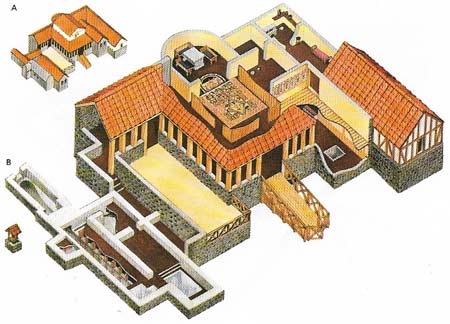
Figure 1. The Roman villa at Lullingstone, in Kent (shown here in model (A) and cutaway (B) was built on an ancient site. The first stone house to appear on the site was probably built by a British farmer in the 1st century AD. By the end of that century it was occupied by a Roman and was greatly expanded by the addition of baths and other rooms. The house stood empty for most of the 3rd century until it was taken over by a prosperous Romano-British family. During the 4th century its celebrated mosaic floor was laid in a new reception room and another room was converted into a Christian chapel. The house was abandoned in about 400.
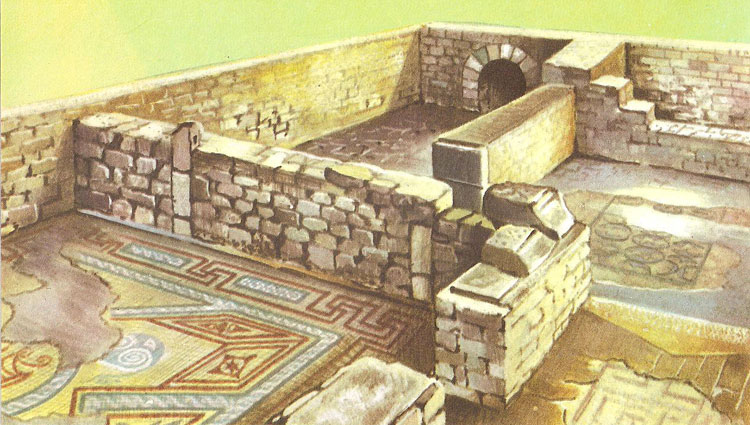
Figure 2. A view of some of the rooms at the Roman villa at Chedworth, one of the largest Roman villas to be found in Britain.
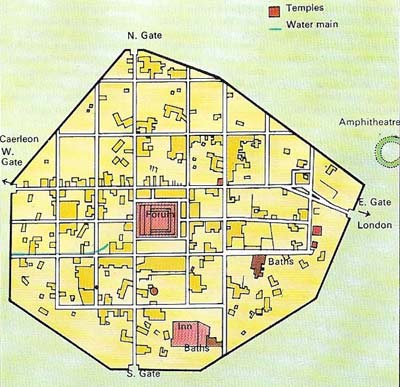
Figure 3. Silchester, in Hampshire, is the only Roman town in Britain that has been completely excavated. The first town on the site, where seven main Roman roads met, is thought to have been founded about AD 45. It is a typically Roman town in its grid-iron arrangement, buildings such as baths and temples, its residential areas and its open spaces. The center, as in Rome itself, was the forum, a large square surrounded by public buildings and shops. The most important building was the basilica, a long hall where business was transacted. The shops in the forum were more elaborate than the ordinary shops, which served also as houses and sometimes as workshops.
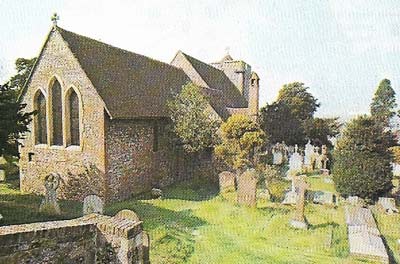
Figure 4. St Martin's Church, Canterbury, is probably the oldest Christian church in Britain. It is also the only building in the country that was used for Christian worship in both Roman and Anglo-Saxon times. Before being adapted for Chrsitian use, the site had served as a pagan temple for Romano-Celtic religions. The Kentish queen Bertha worshipped there in the 6th century and St Augustine used it as his headquarters for his mission to re-Christianize England in 597. The western wall is Roman and was probably the wall of the church of Durovernum, built in the 3rd or 4th century. Few other buildings in Roman towns have been identified as specifically Christian edifices; usually small square rooms were set aside for worship.
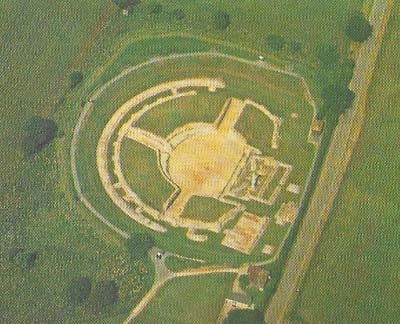
Figure 5. The theater at Verulamium (St Albans), which was built in about AD 140, is one of only three found in Britain. It was used not only for plays but also for dancing, wrestling, and bear-baiting. The audience sat on a semicircular bank of raised seats, with leading citizens occupying the front rows.
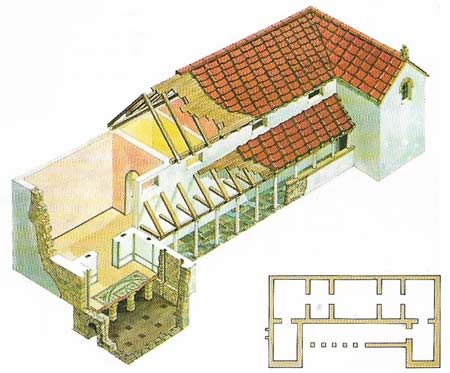
Figure 6. Romano-British farmhouses were generally single-story buildings with rooms leading into one another rather than off a corridor. There were usually a number of buildings in addition to the living quarters.
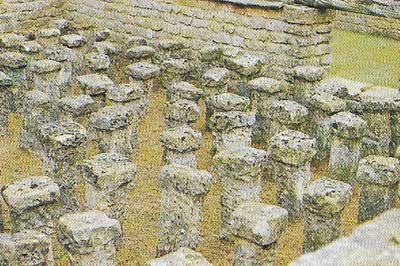
Figure 7. The central heating system (part of which is shown) at Chedworth Roman villa, near Cheltenham, worked by means of a hypocaust. In every Roman villa in Britain, one or more rooms were heated by the same means. The principle of the hypocaust were simple but effective. It consisted basically of a furnace below ground-level, which was fed with charcoal by a stoke-hole located in an outside wall. The hot air from the furnace was drawn through channels under the floors (which were supported by tiled pillars) and from there up through small flues in the walls. In Mediterranean lands hypocausts were usually installed only for heating the baths, but the rigorous British climate demanded a more elaborate and effective system.
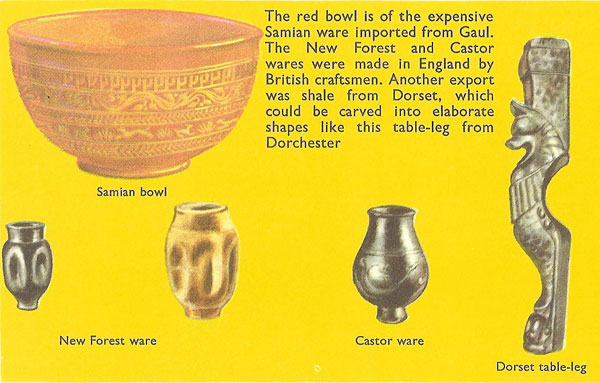
Figure 8. Various Roman artefacts found in Britain.
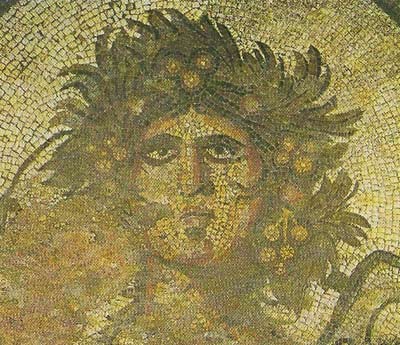
Figure 9. Mosaics, such as this 2nd-century depiction of autumn from a villa at Corinium (Cirencester), were put in many public and private buildings of Roman Britain. They often represented mythical scenes. The invaders tried to bring their Mediterranean style of life to Britain, adapting it as little as possible.
For nearly 400 years, from AD 43 to 410, most of Britain was occupied by the Romans. In the Dark Ages which followed the capture of Rome by Alaric and the Goths in 410 and the invasion of Britain by waves of northern European peoples, most traces of the Roman occupation of Britain were swept away. The Romans had not needed to build in Britain huge aqueducts like those in their other conquered provinces, and only Hadrian's Wall was too large to be utterly destroyed by invaders from other lands. Most of the Roman towns and villas, and the way of life they had stood for, disappeared. Nevertheless, the Roman occupation left a lasting impression on the English language and on the roads of the island, as well as in other less easily definable ways.
In Celtic times Britain was already a prosperous country. The Romans rapidly in-creased its prosperity. Their colonial policy aimed at winning the approval of the upper classes by founding new centers such as Lincoln in the countryside, or by introducing Roman civilization to existing tribal centers. Their way of life affected the lower classes only slightly and gradually.
Government
Like the other provinces of the Roman Empire, Britain was governed by a propraetor, who held office for a period of about five years. He was usually a distinguished soldier, and during the first two centuries it was rare for a governor not to have to deal with at least one rising by the conquered Britons, or an invasion from the north of England, which the Romans never succeeded in subduing completely. Next to the propraetor came the procurator, an independent official responsible for the financial administration, and answerable only to the government in Rome.
The Roman policy was to encourage the inhabitants of the lands they conquered to run their own affairs as far as possible, but to do so on Roman lines. So a Britain living in the heart of the country would have had little to do with any Roman official; his district would have been run by the Senate in the local town. This body consisted of important local Britons and was run on the same lines as the Senate in Rome – much in the same way as many countries in the British Commonwealth have their parliaments modeled on the British parliament.
Life in the towns
At the center of the typical Roman town (Figure 3) was the forum, round which were grouped buildings such as the basilica (hall of justice and public meeting-place), curia (council chamber), temples, baths, and shops. The shape of each town was essentially that of Rome itself. The streets were paved and some had main drains beneath them to which house drains could be linked. Principal buildings were constructed of stone, with timber buildings surrounding them, and in the bigger towns wealthy Romans and Britons owned houses built of brick.
Laborers and craftsmen lived in simple rectangular houses made of wood, set with their longer dimension at right-angles to the street. They doubled as shop-front and workshop, the living rooms being set behind the working areas or on an upper floor and equipped with furniture and utensils that were usually homemade. Merchants' houses were larger, and made of brick, with an internal courtyard. They might have a hypocaust (Figure 7) (a system of underfloor central heating), a flush latrine (fed by rainwater collected in a lead tank on the roof), mosaic floors (Figure 9) and brightly frescoed interior walls.
In Roman eyes the bath house was an essential feature of civilized life and even the smallest town had one, centrally placed and open to all. Amphitheaters were important, apart from the entertainment they provided, for the urban solidarity they demonstrated. The Romans enjoyed violent entertainments: as well as chariot races in which blood was shed accidentally, there were gladiatorial performances in which it was shed deliberately. Amphitheaters seating perhaps 5,000 spectators can still be seen at Silchester and Dorchester. Theatres existed in only the most important towns, such as St Albans (Figure 5).
Britons who lived in the towns, or visited them regularly, probably adopted the dress of the Romans. Those who, as Roman citizens, were entitled to wear a toga probably did so on formal occasions. Others wore tunics and, out of doors, hooded cloaks. Soldiers serving at Hadrian's Wall are known to have worn socks and underpants.
There was considerable interchange between Roman and Briton. Soldiers on the northern frontier, for instance, spoke a British dialect of Latin and drank not only imported wine but also "Celtic beer". Civilian settlements grew up beside forts and even in its most remote outposts the Roman army lived constantly in the company of the people it had conquered.
The countryside
By modern standards the Roman towns i Britain were small and thinly populated. Even London, the largest and most important of them, had fewer inhabitants than the average county town of today, and the bulk of the British population lived in the countryside. We know very little about the life these people lived in their villages and how far they were influenced by Roman civilization; most of the evidence which would answer our questions about this has been destroyed. However, a number of villages have been excavated on Salisbury Plain, and we can learn a good deal from them. Some houses had adopted the Roman method of central heating, though in a rather simple form, and tiles with Latin words scratched on them show that Latin was at any rate understood, though the villagers continued to talk among themselves in a Celtic language.
But there was another more advanced style of country life in Roman Britain – the Roman villa. About 500 of these have been found all over the parts of Britain which the Romans occupied, though they were largely owned by Britons, not by Romans. The elaborate buildings with their central heating, the beautiful mosaics, and large farms, show how much the wealthier Britons were influenced by Roman civilization.
Agriculture and industry
Within Roman Britain the pattern of agricultural life seems to have changed little; even in their colonies, or settlements of veteran soldiers, the Romans do not seem to have brought to bear their improved agricultural technology. Most villas (Fig 1) were comparatively simple and even the most luxurious were primarily productive farms.
Agriculture was the means of subsistence of most people in Roman Britain (8); after that came textiles, above all wool. Numerous varieties of weave have been unearthed at Vindolanda, near Hadrian's Wall, where remains of a tannery were also found. Wine, olive oil, and works of skillful craftsmanship were imported into Britain, but in return Britain exported wool and, after native potters had learnt from the Romans, pottery such as Castor ware. Mineral deposits were worked by the Romans to a much greater degree than ever before.
The Romans were naturally anxious to make the province pay, and they encouraged every sort of industry that might bring in money. Very soon after their conquest of the country, lead was being mined in the Mendips. Silver and gold were mined in small quantities, and so were tin and iron. The wealthy villa-owners bred sheep on their large farms and there was a large-scale export of wool. Among lesser exports, British hunting dogs were in great demand.
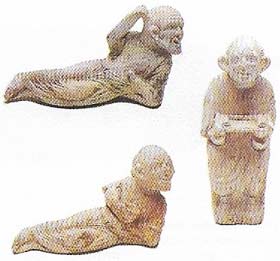 |
| Pottery figurines fashioned to represent diners and reciters were excavated from a Roman child's grave at Colchester. The stocky build and general facial characteristics of the figurines suggest that they depict men from northern Italy. It is known that after AD 49, veteran soldiers, mostly Italian, increasingly settled at Colchester and raised families. Eventually there were several thousand members of this community. |
The Roman ideals
The roads that fostered the urban way of life, and made Britain for the first time a living unity, were built primarily for the uses of the army and the administration. For those who used them there were mansions (staging-posts) provided at regular intervals of ten Roman miles. A typical mansion had six guest rooms, a heated dining room, a kitchen and a small bath house, all of which, together with the staff, had to be maintained by the local community. Another significant way in which Britain was now unified was in the law, which probably did much to spread the use of Latin among the upper classes.
There was great variety in the practice of religion. Claudius had from the first introduced emperor worship, but this was a comparatively small part of a Roman's typical round of religious duties. The Romans had done their utmost to stamp out Druidism, for they violently disapproved of its human sacrifices, but they were otherwise tolerant either of the religions they had imported, such as Mithraism, originally from Persia, or of the native religion, of which little is known. The chief Celtic deity seems to have been a figure whom the Romans identified with Hercules. Christianity made some converts, mostly in the fourth century (Figure 4).
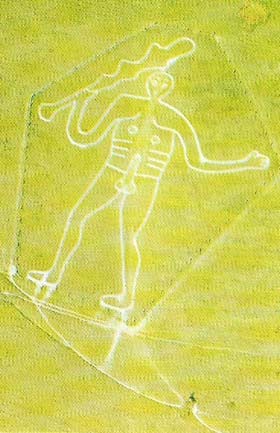 |
| The Cerne giant was cut in the chalk of a hillside north of Cerne Abbas in Dorset in the late Roman period. The figure stands 55 meters (180 feet) tall and holds a club. It has been suggested that the giant is a British adaptation of the cult of Hercules, which was early introduced into Britain by the Romans and has been found in various parts of the country. |
When the Romans departed, the country quickly lapsed from its civilized ways. But the memory of Rome remained for centuries afterwards an ideal to which the emergent nation had continual recourse.
Art
When the Romans first came to Britain there was a flourishing Celtic art, one of the most striking examples of which is the so-called Battersea Shield. The influence of Roman art on native craftsmen was not entirely beneficial, as a great deal of the freedom and movement of Celtic art was lost. Only in pottery were their arts successfully combined with those from abroad. The most famous Roman pottery was the Samian ware – smooth, glowing red pottery, decorated with molded figures. Such pottery was naturally very expensive, and the Castor ware, which the British potters made in imitation of it, has a vigor and life which is all its own.
But, generally speaking, there were no great British artists during the Roman occupation, and all the most important works of art that have been discovered were made by foreign craftsmen. The mosaic floors of the villas were laid by Greek artists who came especially for the purpose, though they may have been assisted by British craftsmen.
One find in particular deserves to be mentioned, though here again it was the product of foreign artists, and that is the great Mildenhall treasure of silverware, dating from about AD 380, just before Britain lost to Rome. This magnificent silver gives us some idea of the standards of wealthy Britons.
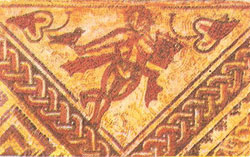 |
| Part of a mosaic floor from Chedworth depicting Spring |
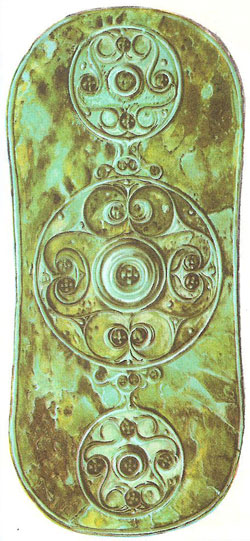 |
| The Battersea Shield. This enameled bronze shield,
found in the Thames at Battersea, is one of the masterpieces of Celtic
art |
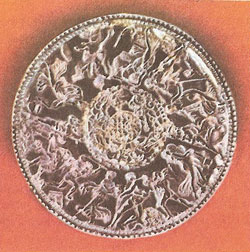 |
| The Mildenhall Dish, the chief item in the treasure
found at Mildenhall (in Suffolk). It shows a Bacchic dance and sea
nymphs |
Religion
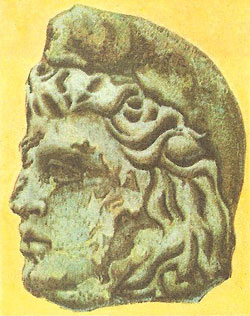 |
| Head of the Persian god Mithras found in a temple
excavated in London. The cap he is wearing is known as a Phrygian
cap
|
The Romans made little effort to impose their own religion on the countries they conquered, and seldom interfered with the religions they found; the only exception to this rule was the Druid religion, which they destroyed because it involved human sacrifice. Nevertheless, some of the Roman gods and goddesses were adopted by the Britons and gave their names to local deities. The worship of Mithras, which was originally Persian, was very popular with the Roman army, and shrines showing Mithras slaying the bull (which represented the powers of darkness) have been found in many places. There is no evidence that this religion was ever widely adopted by the Britons.
The only religion that the Romans tried to introduce was the worship of the reigning emperor; immediately after the conquest a large temple was built to the Emperor Claudius at Colchester, and the taxes charged for building it were partly responsible for Boadicea's revolt. Christianity seems to have taken some time to establish itself in Britain. St Alban, the first British martyr, was put to death during the persecution of Diocletian in 290, but the earliest Christian church (at Silchester) is not earlier than the end of the fourth century.
